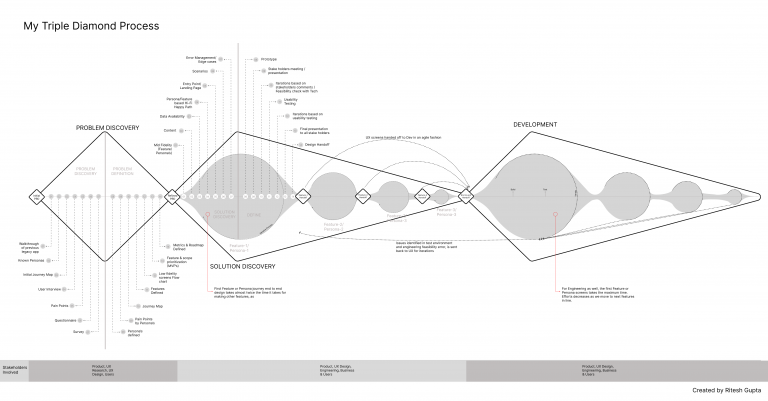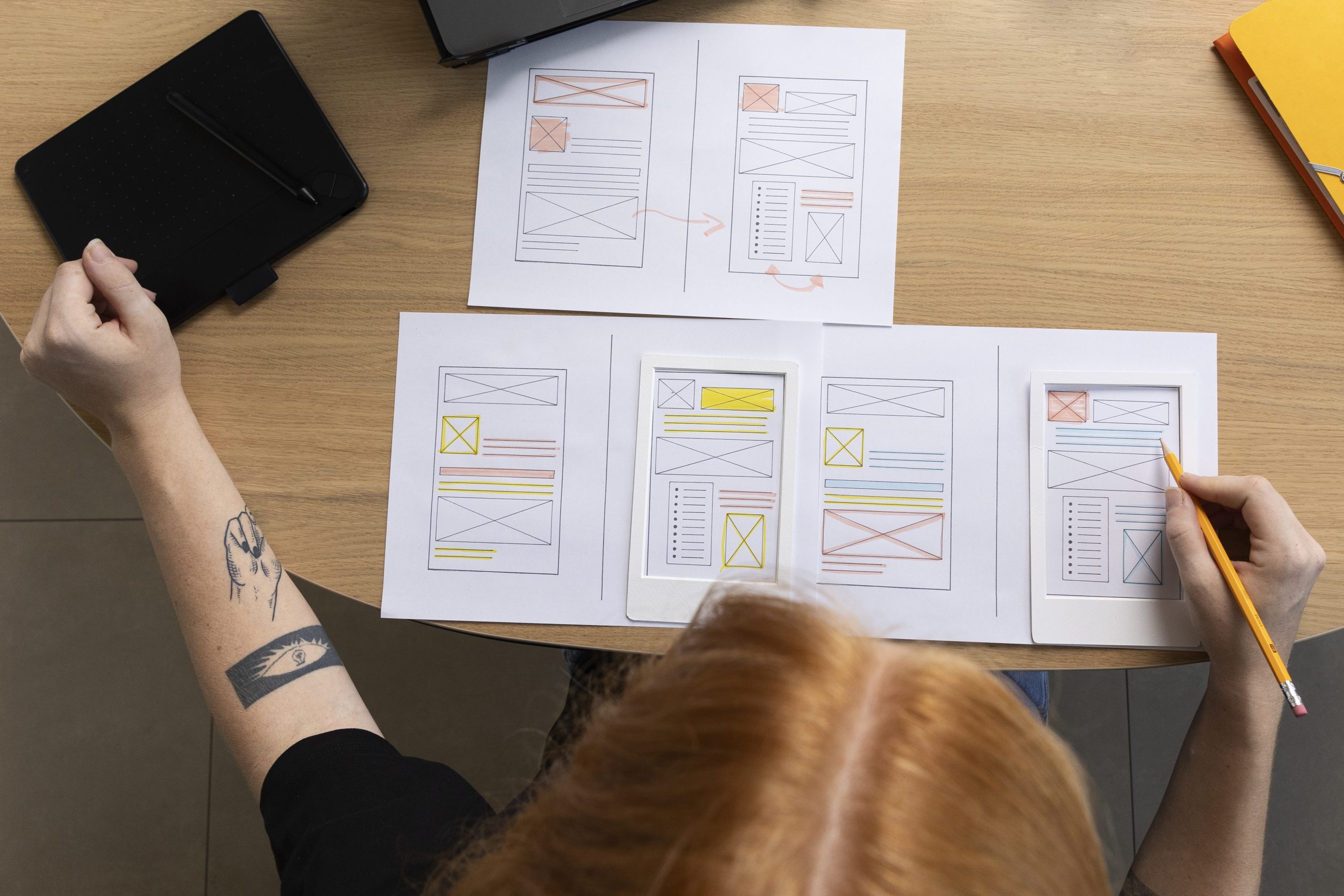
Overall Design Process Infographic
My UX Design Process: A Journey of User-Centered Design
Great design doesn’t simply happen; it’s a journey fueled by curiosity, empathy, and a relentless pursuit of understanding. As a UX Designer, I embark on this journey with every project, starting with the spark of a question: who are we designing for, and what challenges do they face?
This question forms the cornerstone of my user-centered, meticulous, and ever-evolving approach. I believe that truly impactful solutions don’t just look good, they empower users. That’s why I prioritize understanding the people behind the screens, their needs, motivations, and frustrations. By delving deeper, I can craft solutions that resonate and make a real difference.
This journey unfolds in a series of collaborative phases, each meticulously crafted to gather insights, explore possibilities, and ultimately, deliver a design that thrives in the real world. From collaborating with stakeholders to define goals and user research methods, to crafting user personas that bring user needs to life, every step is fueled by the desire to design for the people who matter most.
My approach is data-driven, leveraging research findings and user feedback to guide design decisions. But it’s also deeply personal. I believe in the power of empathy to bridge the gap between theory and practice, allowing me to connect with users on a human level and translate their experiences into meaningful design solutions.
This isn’t just a process; it’s a continuous exploration. As technology and user needs evolve, so does my approach. I constantly learn and adapt, embracing new tools and methods to refine my craft and deliver the best possible experiences.
So, as you delve deeper into my portfolio, remember that every design you see is a testament to this ongoing journey. It’s a story not just about lines and colors, but about people, their needs, and the impact we can create through the power of user-centered design.
Let me take you through the most generic process that I follow in my day-to-day UX design work:
1. Discovery: Unearthing User Needs
Before I even touch a pen or open a design tool, I embark on a crucial first step: discovery. This phase is the foundation upon which everything else rests, a treasure hunt for the hidden gems of user needs and insights.
This isn’t just about collecting data; it’s about building empathy. By stepping into their shoes and experiencing the world through their eyes, I gain a deeper understanding of their needs and desires. This understanding becomes the compass that guides me throughout the design process, ensuring every decision is aligned with the user’s journey.
So, as you explore my work, remember that every design decision originates from the stories uncovered during this crucial phase. It’s a testament to the power of understanding the human element, and the belief that empathy is the key to creating truly impactful experiences.
-
Discovery is a collaborative effort as well. I work closely with stakeholders to ensure everyone is on the same page, from understanding project goals to interpreting user research findings. This open communication fosters a shared understanding of the user and sets the stage for a successful design journey. The first step involves defining the project’s goals and scope alongside key stakeholders. We work together to establish clear objectives, determine the specific product or service being designed, and set boundaries for the project. This ensures everyone is aligned and focuses on the most impactful areas.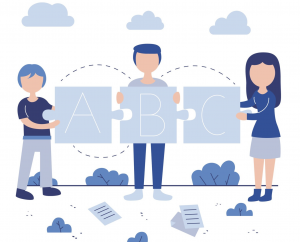 Collaborating with stakeholders:
Collaborating with stakeholders:
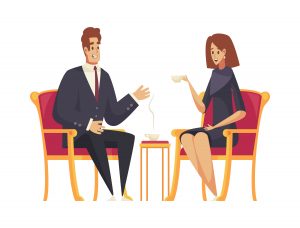
-
Conducting user research:
Here’s where my curiosity goes into overdrive. I relish the opportunity to connect with people, Through various research methods like interviews, surveys, user testing, and competitor analysis, I gather and analyze valuable data and insights. Each interaction, each survey response, becomes a piece of the puzzle, revealing a glimpse into the user’s world. This treasure trove of information helps me identify user needs, pain points, and desires, allowing me to truly empathize with their experiences and frustrations. Click this link to see some examples of user research I conducted
-
Building user personas:
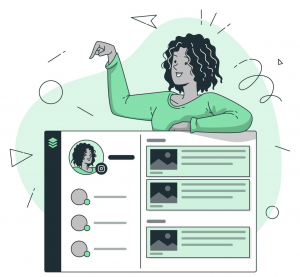 I believe that every user has a story, and it’s my job to listen – to hear their frustrations, understand their motivations, and discover the hidden challenges that lie beneath the surface. Through this process, I begin to craft user personas – not just fictional characters, but living, breathing representations of the people I’m designing for. These fictional characters, meticulously crafted based on research findings, represent key user segments. Each persona comes to life with detailed demographics, behaviors, goals, and challenges. By constantly referring to these personas, I ensure the design solutions cater directly to the needs of real people
I believe that every user has a story, and it’s my job to listen – to hear their frustrations, understand their motivations, and discover the hidden challenges that lie beneath the surface. Through this process, I begin to craft user personas – not just fictional characters, but living, breathing representations of the people I’m designing for. These fictional characters, meticulously crafted based on research findings, represent key user segments. Each persona comes to life with detailed demographics, behaviors, goals, and challenges. By constantly referring to these personas, I ensure the design solutions cater directly to the needs of real people
-
Competitive analysis:
No island exists in isolation. I delve into the competitive landscape, analyzing existing solutions in the market. This allows me to understand the strengths and weaknesses of competitors in terms of user experience, functionality, and design. Identifying unique opportunities for differentiation becomes crucial, setting the stage for innovative and user-centric solutions.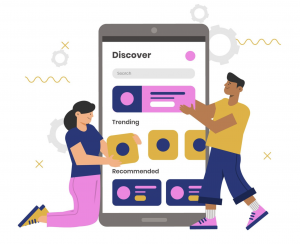
2. Defining the Blueprint: Information Architecture & User Journeys
-
Information Architecture: The Inner Cartographer Takes the Wheel
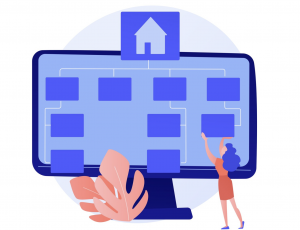
Just like navigating a bustling city for the first time, users shouldn’t feel lost or overwhelmed when interacting with a product. To ensure a smooth journey, I step into the role of the inner cartographer. This involves meticulously organizing the information, and crafting a clear and intuitive structure that allows users to find what they need effortlessly.
Imagine information as the streets and avenues of a digital landscape. My task is to visualize the flow of this information, ensuring a logical and user-friendly experience. This means laying out the hierarchy of content, just like ranking the importance of different landmarks in a city map (I sometimes use card sorting as one of the tools). Ultimately, the goal is to empower users to navigate the landscape with ease, reaching their destination without confusion.
-
User Journeys: Weaving Tales for Design Excellence
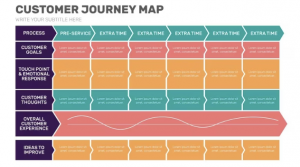
User journeys become my storyteller’s tool, helping me map out the steps users take to complete specific tasks. Think of them as the narratives that unfold within the digital landscape. By visualizing these journeys, I gain a deeper understanding of the user’s perspective, allowing me to:
- Identify potential roadblocks: Imagine unexpected detours or confusing signage on a map. User journeys help me identify these roadblocks – moments where users might encounter difficulty or frustration.
- Understand where users might get lost: Like navigating a maze, user journeys reveal potential points where users might lose their way within the product. This allows me to anticipate these moments and offer clear guidance.
- Pinpoint opportunities to improve the user experience: Just like improving signage or adding landmarks to a map, user journeys help me identify areas where the experience can be enhanced to make it smoother and more efficient.
- Helps in identifying all touchpoints and prioritizing based on multiple factors
This process involves a touch of empathy. I walk through the user’s journey in their shoes, experiencing the product from their perspective. By identifying pain points and areas for improvement, I can craft a user experience that resonates with their needs and expectations. Click this link to see some examples of Journey Map I have designed
-
Collaboration: Refining the Blueprint Together
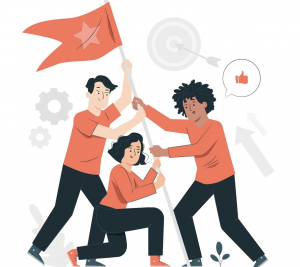
The blueprint isn’t built in a vacuum. I believe in the power of collaboration, working closely with stakeholders to refine both the information architecture and user journeys. Together, we ensure that they:
- Align with the overall project goals: The blueprint needs to act as a compass, guiding the design journey towards achieving the desired outcomes.
- Remain user-centered: Throughout this process, the user remains at the heart of every decision. Collaboration ensures that the blueprint reflects their needs and priorities.
- Deliver an impactful experience: The ultimate goal is to create an experience that makes a positive difference for users. By working together, we can ensure that the blueprint is a roadmap to success.
So, the next time you encounter a user-friendly and intuitive product, remember the unseen work that goes into defining the blueprint. It’s a testament to the power of strategic planning, empathy, and a collaborative spirit, all working together to create impactful design experiences.
3. Ideation & Prototyping: Transforming Ideas into Interactive Experiences
With the foundation laid through research and the blueprint meticulously crafted, it’s time to unleash the magic of ideation and prototyping. This is where the sparks of creativity ignite, transforming abstract ideas into tangible experiences.
-
Rough Fidelity/Mid Fidelity Sketches: The Power of the Imperfect
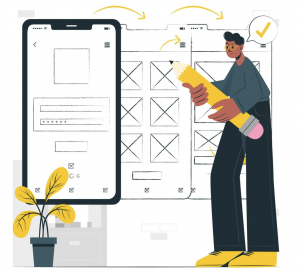
I believe that some of the most powerful ideas start rough. That’s why I embrace the power of rough fidelity sketches. These are like the initial brushstrokes of a painting – a chance to explore possibilities, iterate quickly, and map out the full end-to-end process from the user’s perspective, specifically tailored to our personas.
These sketches aren’t about creating polished perfection; it’s about focusing on functionality and navigation. It’s a chance to identify potential issues early on, gather valuable data about each screen’s purpose and content, and even determine the level of development effort required for different features.
-
High-Fidelity Design: Refining the Vision
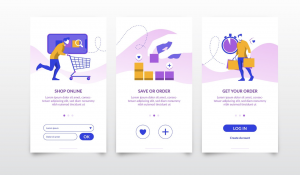
Once the core functionalities are ironed out through rough sketches, I can then move on to high-fidelity design. This is where the details come into play, where I refine the visual language, user interface (UI) elements, and overall aesthetics of the experience.
Here, it’s about creating a visually compelling design that resonates with the user and complements the brand identity. But remember, form follows function. The visual elements should enhance the user experience, not distract from it.
-
Clickable Prototypes: Bridging the Gap Between Design and Reality
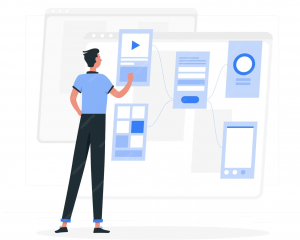
Finally, with the visual design polished, I leverage the power of tools like Figma to create a clickable prototype. This takes us a step closer to reality, allowing users to interact with the design, navigate through different screens, and experience the flow of the entire process.
Prototypes serve as a crucial bridge between design and reality. They allow for usability testing, where real users can interact with the design, providing invaluable feedback on its effectiveness and highlighting any potential areas for improvement. This user feedback becomes the fuel for further iteration, ensuring the final product is not just beautiful, but also intuitive and user-friendly.
4. User Testing & Iteration: Refining the Design through User Feedback
The design journey doesn’t end with a polished prototype. It’s here, in the realm of user testing and iteration, that the true magic happens. This is where the rubber meets the road, where the design confronts its intended audience and learns from their invaluable feedback.
-
A Symphony of Research Methods:
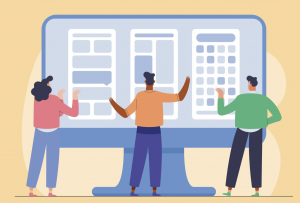
To truly understand how users interact with the design, I employ a symphony of research methods. Each method plays a distinct role in the orchestra of user research:
- Usability Testing: Users are invited to interact with the prototype, allowing me to observe their behavior, identify any usability issues, and witness firsthand how they navigate the experience.
- A/B Testing: This allows me to compare different design variations and see which one performs better with users, helping me make data-driven decisions for optimization.
- Guerilla Testing: Sometimes, the best insights come from unexpected places. Guerilla testing involves quickly testing the prototype with readily available users, like people in a coffee shop or park, offering valuable and diverse perspectives.
- Interviews and Surveys: These methods allow me to delve deeper into the user’s thoughts and feelings, providing a qualitative understanding of their experience beyond just observing their actions.
-
Embracing the Power of Feedback:
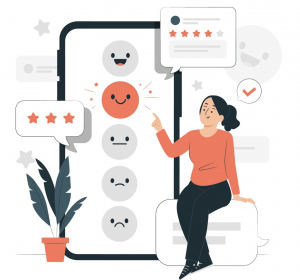
The feedback gathered through these methods is like precious gold. It allows me to listen, learn, and empathize with the user’s experience. I actively seek out both positive and negative feedback, understanding that even the most well-intentioned design can have unforeseen shortcomings.
-
Iteration: The Engine of Design Excellence
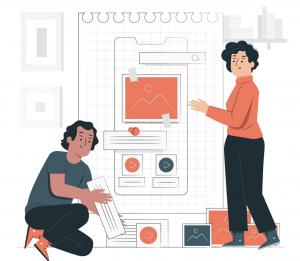
With every piece of feedback, the design undergoes iteration. This is not about starting from scratch; it’s about refining and improving what already exists. By incorporating user insights, I can address usability issues, enhance clarity, and create an experience that truly resonates with the user’s needs and expectations.
This iterative cycle continues until the design reaches a point of optimal functionality and user satisfaction. It’s a testament to the power of humility, empathy, and a constant commitment to learning. By embracing user feedback and adapting the design accordingly, we can create experiences that not only look good, but also work beautifully for the people who matter most.
5. Collaboration & Handoff: Working Seamlessly with the Team
As the design journey nears its completion, it’s time for collaboration and handoff. This is where the baton is passed from the world of design to the capable hands of the product, frontend, and backend tech teams. It’s a crucial step in ensuring a seamless transition and achieving the final vision.
-
Figma: The Bridge of Communication
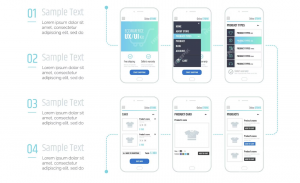
To facilitate this transition, I leverage the power of tools like Figma. This Figma handoff file becomes the bridge of communication, allowing me to create a comprehensive handoff file. This file is not just a collection of visuals; it tells a story, acting as a roadmap for the development team.
-
Clarity is Key:
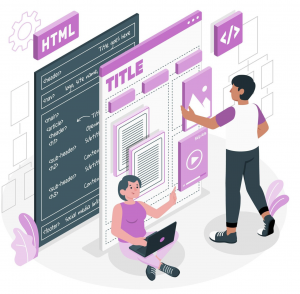
The handoff file is meticulously crafted with clear instructions. Every element, from the flow of the design marked with arrows to the purpose of each screen, is explained with concise and well-structured documentation. This ensures everyone on the development team understands the design intent and can translate it into a functioning product.
-
Beyond Aesthetics: Embracing Accessibility and Collaboration
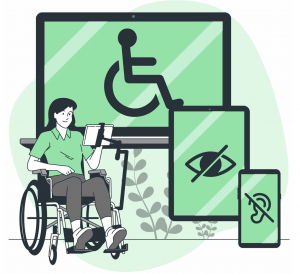
But the story doesn’t end there. As a designer, I am committed to accessibility. This means ensuring the design is usable by everyone, regardless of their abilities. To achieve this, I include alt text for images, providing crucial context for users who rely on screen readers.
Furthermore, the handoff file itself becomes a tool for collaboration. Backend comments can be included to address potential technical considerations, fostering open communication between designers and developers. Additionally, the clickable prototype within Figma allows product and tech teams to experience the design interactively, ensuring a shared understanding of the user journey.
-
Embracing the Unexpected: Iteration is a Team Effort
The handoff process is not always a smooth, linear path. Sometimes, during development, unforeseen technical limitations may arise. In these instances, I embrace the power of iteration. Together with the development team, we can explore alternative solutions, refine the design as needed, and ensure the final product remains true to the user-centered vision.
6. Visual Quality Assurance (VQA): Ensuring Design Meets Reality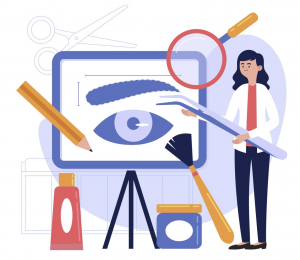
The design journey might be nearing its final destination, but there’s still one crucial step remaining: Visual Quality Assurance (VQA). It’s like the final brushstrokes on a painting, ensuring the design vision translates flawlessly from the designer’s canvas to the developer’s digital world.
-
Meticulous Attention to Detail:
During VQA, I become a detail detective, meticulously inspecting the developed product against the original design intent. This involves comparing every element, from the pixel-perfect placement of buttons to the precise use of color and typography, ensuring they match the design specifications.
-
Collaboration for Success:
VQA isn’t a solo act; it’s a collaborative effort. Open communication with the development team is key. If any discrepancies are identified, I work closely with them to understand the potential limitations and explore solutions that maintain the overall design integrity while adhering to technical constraints.
-
Beyond Perfection: Celebrating the Journey
VQA isn’t just about achieving pixel-perfect accuracy; it’s about celebrating the journey. It’s the culmination of months of research, ideation, and collaboration, witnessing the design vision come to life.
Every successful VQA process is a testament to the power of meticulous attention to detail, open communication, and a shared commitment to excellence. It’s a reminder that great design isn’t just about aesthetics; it’s about translating ideas into tangible experiences that resonate with users and leave a lasting positive impact.
7. Beyond the Process: Embracing the Journey of Growth
The design journey might seem to have a finish line, but for me, it’s a continuous loop – one that never truly ends. This is where the spirit of continuous learning and improvement comes into play.
-
Never Stop Exploring:
Beyond the established steps of the process, I believe in fostering a growth mindset. I am constantly seeking new knowledge by staying updated on the latest design trends, user research methodologies, and industry best practices. This involves devouring design articles, attending workshops, and engaging with the design community.
-
Evolving with the Landscape:
The design landscape is ever-evolving, and so too must my approach. By actively learning and adapting, I ensure that the tools and techniques I use remain cutting-edge and relevant. This allows me to tackle new challenges with fresh perspectives and innovative solutions.
-
Impactful Design as a Constant Pursuit:
Ultimately, my goal is not just to create usable products, but to craft experiences that leave a lasting impact. By continuously learning and refining my approach, I aim to deliver user-centered designs that are not only intuitive and effective but also innovative and truly impactful.
The journey of design is an ever-winding path, filled with new challenges and opportunities to learn and grow. This continuous exploration fuels my passion for creating meaningful experiences that improve user lives. So, while the specific steps of a project may come to a close, my commitment to learning, evolving, and pushing the boundaries of design remains an ever-burning flame.
